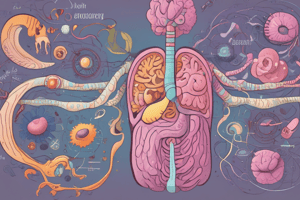Podcast
Questions and Answers
What is the first biological reaction that occurs with biomaterials?
What is the first biological reaction that occurs with biomaterials?
- Adsorption of proteins (correct)
- Inflammatory response
- Release of growth factors
- Cell adhesion
What type of protein bonding occurs during adsorption?
What type of protein bonding occurs during adsorption?
- Both low and high affinity bonding (correct)
- Only high affinity bonding
- Low affinity reversible bonding only
- Only low affinity bonding
What can happen if an unspecifically acting protein layer is present during the interaction?
What can happen if an unspecifically acting protein layer is present during the interaction?
- Improvements in biocompatibility
- Cell proliferation
- Inflammatory reaction (correct)
- Enhanced protein function
Which cells are mentioned as being relevant to the biomaterial-tissue interaction?
Which cells are mentioned as being relevant to the biomaterial-tissue interaction?
What facilitates the adhesion of target tissue cells to the implant surface?
What facilitates the adhesion of target tissue cells to the implant surface?
What is the primary goal of surface functionalization of biomaterials?
What is the primary goal of surface functionalization of biomaterials?
What feature is essential for the stability of surface coatings on biomaterials?
What feature is essential for the stability of surface coatings on biomaterials?
What is indicated for the thickness of a PEG monolayer to achieve effective protein adsorption?
What is indicated for the thickness of a PEG monolayer to achieve effective protein adsorption?
Which of the following methods is NOT part of the surface functionalization processes detailed?
Which of the following methods is NOT part of the surface functionalization processes detailed?
What effect do signaling molecules on the implant surface aim to promote?
What effect do signaling molecules on the implant surface aim to promote?
Flashcards are hidden until you start studying
Study Notes
Biomaterial-Tissue Interaction Overview
- Initial biological reaction involves protein adsorption on biomaterial surfaces occurring within seconds.
- This reaction determines the biocompatibility journey of the biomaterial.
- Protein bonding can be classified as reversible (low affinity) or irreversible (high affinity) and may happen via unspecific or specific interactions.
- Usually, proteins adsorb in an unspecific manner with high affinity, leading to loss of their native structure and functionality.
Cellular Response to Protein Layer
- Once proteins are adsorbed, cell populations such as macrophages, granulocytes, immunocytes, and fibroblasts adhere to the surface via integrins that recognize adsorbed proteins.
- Conformational changes in adsorbed proteins may serve as cues for cell behavior, while some fragments can be released dynamically.
- An adsorptive protein layer can potentially trigger inflammatory responses if it acts unspecifically.
Growth Factors and Healing
- Proteins that are released can attract tissue cell precursors by releasing morphogenetic proteins and growth factors.
- Successful integration of an implant relies on biocompatibility facilitating cellular adhesion to the surface.
Surface Functionalization Goals
- Biofunctionalization of biomaterials aims to enhance cell growth and differentiation, speeding up wound healing and promoting permanent integration.
- Possible strategies include coating implants with bioactive materials or directly attaching signaling molecules.
Coating Techniques and Considerations
- Implants can be coated with a bioactive film to enhance properties, requiring careful control of thickness (ideally a few angstroms to tens of nanometers).
- Stability is crucial; coatings must resist delamination and microcracking under challenging conditions.
Types of Bioceramics and Bioactivity
- Bioceramics are categorized into bioinert (e.g., Al2O3, TiO2), bioactive (e.g., bioactive glasses), and resorbable (e.g., tricalcium phosphate).
- Bioactive materials prompt a specific response, forming interfacial bonds with living tissues.
Hydroxy-Carbonate-Apatite Layer Formation
- Hydroxy-carbonate-apatite (HCA) forms on the surface of bioactive materials by migrating calcium and phosphate ions through silicon dioxide layers.
Structural Interfaces in Implants
- The interface stiffness varies, and surface structuring can improve bonding to bone through the effect of surface roughness.
Functionalization of Bioglass® Surfaces
- Bioglass surfaces can undergo silanization and glutaraldehyde treatment for protein coupling, facilitating controlled release of growth factors.
Surface Modification Techniques
- Non-covalent (physical) modifications involve techniques like physisorption and layering organic films.
- Covalent modifications can be achieved through grafting, photoreactions, plasma treatments, and silanization to enhance protein attachment.
Protein Attachment Dynamics
- Hydrophilic areas on surfaces generally favor protein and cell attachment, while extremely hydrophobic or overly soft surfaces may be unattractive.
- Surface charge influences how effectively proteins and cells adhere to biomaterials.
Biological Immobilization
- Potential immobilization strategies include integrating biologically active proteins within polymer matrices, allowing for higher loading compared to physical adsorption.
- Techniques for surface treatment can include deposition of hydroxyapatite on collagen networks for enhanced biocompatibility.
Studying That Suits You
Use AI to generate personalized quizzes and flashcards to suit your learning preferences.





